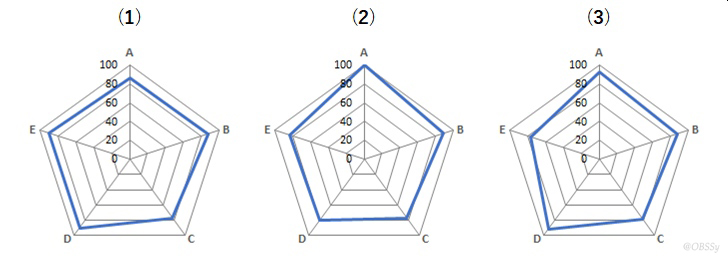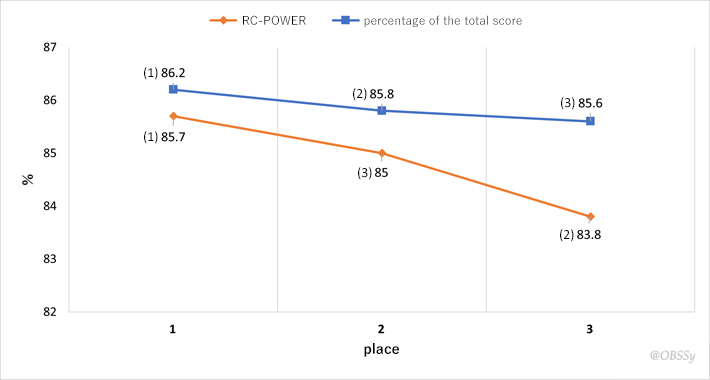The ranking by RADAR CHART POWER ( RC-POWER ) ® is in order of well-balanced high scores on multiple perspective items. The ranks with large point differences are the guide of judgment.
For example, when selecting one of the many products by comparing radar charts showing multiple perspectives scores, we want to find the product with the most well-balanced high scores possible while still focusing on the items we strongly desire.
If you have a ranking of the order of scoring well-balanced points from the perspective items, you can make a satisfying selection. Because you can consider a combination of the ranking and scores on items important to you.
Let’s consider a ranking using observation, the total score, and the RC-POWER. For more information on RC-POWER, refer to RADAR CHART POWER.
As for the three products (1), (2), and (3), each product has an evaluation of five items. A perfect score for each item is 100. We consider ranking by the scores and the radar charts shown in Table 1 and Figure 1.
Table 1 The evaluation examples with five items.
| Item | (1) | (2) | (3) |
|---|---|---|---|
| A | 86 | 100 | 93 |
| B | 88 | 89 | 88 |
| C | 77 | 77 | 78 |
| D | 90 | 80 | 92 |
| E | 90 | 83 | 77 |

Figure 1 Radar charts of the evaluation examples in Table 1.
Ranking by observation
You can see that the first place is (1) because it is the largest and close to a regular pentagon by looking carefully. The second place would be (3). Although (2) creates the illusion of having larger overall values because A is the higher value at noon, C, D, and E have almost 80 points. Thus, (2) is lower than (3) and would be the third place. The ranking is (1), (3), and (2).
However, this ranking is uncertain because observation does not quantify differences between the ranks. Although observation is essential to grasp the overall, there is, unfortunately, a trap of the perceptual illusion.
Ranking by the total score
The total score is (1) 431 points, (2) 429 points, and (3) 428 points, and the ranking is (1), (2), and (3), which does not match the observation. The total score is an index of different characteristics from one we perceive by observing the radar chart.
Ranking by the RC-POWER
The RC-POWER is (1) 85.7%, (2) 83.8%, and (3) 85%. The larger the score of each item and the better their balance, the larger the RC-POWER. The ranking is consistent with one by the observation: (1), (3), (2).
Rankings by observation and by the RC-POWER matching
Summarize the above ranking in Table 2.
Table 2 Observation, total score, and RC-POWER ranking.
| Specification | 1st place | 2nd place | 3rd place |
|---|---|---|---|
| observation | (1) | (3) | (2) |
| total score | (1) | (2) | (3) |
| RC-POWER | (1) | (3) | (2) |
The rankings match on the observation and the RC-POWER, but in the total scores, the 2nd and the 3rd are reversed.
As in this example, if the ranking by the total scores is presented along with the radar charts, there is no objection to it because we can confirm it by calculation. However, it raises questions about it because it is not consistent with the ranking by observation.
At this time, if the ranking by the RC-POWER is shown, it matches the observation. So, we are satisfied with that ranking.
The integrated value by the RC-POWER is correlated with the geometric properties based on observation because it calculates how well a radar chart has well-balanced high scores using the shape and size of the radar chart.
On the other hand, the total score does not always correlate with the geometric properties corresponding to the balance of the radar chart. The ranking by the total score is different from observation, which leads to questions.
Difference between the RC-POWER and the total score
Figure 2 shows the RC-POWER and shows (1) 86.2%, (2) 85.8%, and (3) 85.6% as percentages of the total score for the perfect 500 points.
Figure 2 A change of the RC-POWER and the total score (%) in order of ranking.
The RC-POWER makes the difference between the 1st and the 2nd and between the 2nd and the 3rd 0.7% and 1.2%, respectively. However, in the total score, the differences make slightly 0.4% and 0.2%, respectively.
Let us consider what might cause the large gap in values between the 2nd and 3rd of the RC-POWER.
The mean and standard deviation(SD) for the five items for each product are shown in Table 3.
Table 3 Mean and SD.
| (1) | (2) | (3) | |
|---|---|---|---|
| mean | 86.2 | 85.8 | 85.6 |
| SD | 4.8 | 8.1 | 6.8 |
The difference between (2) and (3) on the mean is minor, but (2) is more significant than (3) on SD. Because of this variation, the RC-POWER is (2) 83.8%, (3) 85%, and (2) much lower than (3).
As shown on the page: One in RC-POWER, the RC-POWER combines mean and SD into a single value. The RC-POWER provides rankings by point differentials greater than the total scores.
Summary
The ranking by the RC-POWER has the following characteristics:
- It is a ranking we can accept as it matches our observation.
This is because the RC-POWER corresponds to geometric properties regarding shape and size we perceive from the radar chart. - It is objective.
This is because the RC-POWER is independent of perceptual illusions during observation. - It convinces us.
This is because the reason for the ranking becomes clear. Because the RC-POWER provides rankings by large point differentials by combining mean and SD.

